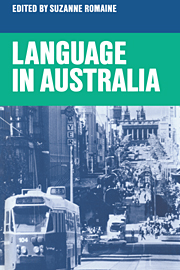Book contents
- Frontmatter
- Contents
- List of illustrations
- List of tables
- Notes on contributors
- Preface
- Acknowledgements
- Introduction
- Part I Aboriginal and Islander Languages
- Part II Pidgins and creoles
- Part III Transplanted languages other than English
- Part IV Varieties of Australian English
- Part V Public policy and social issues
- References
- Index
- Frontmatter
- Contents
- List of illustrations
- List of tables
- Notes on contributors
- Preface
- Acknowledgements
- Introduction
- Part I Aboriginal and Islander Languages
- Part II Pidgins and creoles
- Part III Transplanted languages other than English
- Part IV Varieties of Australian English
- Part V Public policy and social issues
- References
- Index
Summary
Australia is a geographically isolated and largely English-speaking continent surrounded primarily by non-English-speaking neighbours (apart from New Zealand). The story of its languages presents an intriguing case study for sociolinguists. While most Australians today are English monolinguals, the English language is a recent arrival. The majority of the country's original inhabitants were largely multilingual and many still are. The chapters in this book give a comprehensive overview and summary of what is known about the sociolinguistic situation of Australia's major language varieties.
In my introduction I aim to provide a sociohistorical background to the evolution of the major varieties of language now found on the Australian continent. One of the most interesting developments I attempt to trace is how a new ideology of pluralism arose in the 1970s in response to social and political changes. This was in direct opposition to the earlier ‘White Australia’ policy, which projected an image of an ideal Australia which was monocultural, monolingual and monoracial. I also document how Australian attitudes towards language and linguistic diversity have deep historical precedents in the cultural ideology of western Europe and are paralleled in the major Anglophone nations, particularly Britain and the United States. Oppressive policies towards linguistic minorities were practised by the British for a long time ‘at home’ and transplanted to new colonies elsewhere.
- Type
- Chapter
- Information
- Language in Australia , pp. 1 - 24Publisher: Cambridge University PressPrint publication year: 1991
- 2
- Cited by

